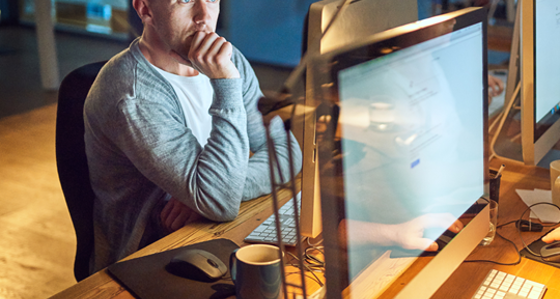
Shift 4: Propositions and experiences - intelligent services
23 March 2020
There is a magical marriage between the needs of a customer and the offering of a brand. Brands who adopt a product approach in isolation of their customers risk going so far. Those who understand needs and wrap their product with an experience benefit from this magical marriage.
What a week it has been. We made the decision to hold and issue this week’s blog to reflect the challenges that we face globally regarding COVID-19.
Last week, we referred to digital leaders coming to a realisation that they must constantly work for their products and services to be hired by customers. This concept hails from Clay Christenson’s Jobs Theory which states that people don’t simply buy products or services, they ‘hire’ them to make progress in specific circumstances – hail the concept “jobs to be done”. If your product can no longer support that progress, you’ll get fired, much like you might as an underperforming employee.
Build what customers really need…
In order for a brand to succeed there is a magical marriage between the needs of a customer and the products or services that an organisation has within their kitbag. This magic happens when your organisation can uncover these sets of needs and create additional value. A simple definition of a proposition is a “product with an experience wrapped around it that utilises the power of a brand to gain traction in a given market”.
Take the last week for example. I have been inundated with messages from organisations that are writing out to customers to talk about COVID-19. There are two examples that stand out to me where brands are proactively reaching out to their customers and inform them of how they will be supporting their needs given the challenges of social distancing and the inevitable lockdown we are heading into:
National Trust – I received a lovely message from National Trust today informing me of the closure of a large proportion of their properties. The message went on to say that I was not to worry as there was some fantastic content that I could use to remain close to them and interact with each of their properties. They will also creating new content for us to consume in a time of isolation so that when we come out the other side we have loads of new information and ideas for the places we are going to visit.
BBC – for the avid EastEnders fans amongst those of you who have read this far, I am sure you will be distraught by the announcement that the Beeb is slowing down releases of episodes to a couple of times a week. For the rest of the UK population who are now considering how they will balance working life with the battle of home schooling v Netflix, the Beeb have an answer – they will shortly be releasing an iPlayer channel dedicated to content for specific school year groups. What a fantastic example of agility in response to a micro change in the BBC iPlayer proposition to help the needs of the families in the UK.
Outside of these trying times, other brilliant examples of this across various industries include:
- Xero – not just accounting; small business management
- Rolls Royce – not just physical aircraft engines; rentable capacity of an engine
- Vitality – not just insurance; a wellness management solution
Don’t build what you think customers need…
Sinclair C5.
It can be easy to think of tens of uses for your product or service. However, not tying these back to specific “jobs to be done” can have detrimental effects. The Sinclair C5 was supposed to revolutionise travel; in a matter of months we’d all be sat down in a relaxed position in an electric vehicle with a 20 mile range instead of walking, cycling and taking public transport. The inventors of the C5 assumed customers would find the uses for their product and as such, you had a product that didn’t have a defined job to be done. This lack of clear application cost the Sinclair brand dearly.
In contrast, roll forward 35 years and look what UberScoot is doing in a number of cities around the globe. This is a proposition not a million miles from the C5 that really solves a customer need, albeit not one that can be universally scaled across the globe due to local law.
The shift from Me to We
An important consideration in this shift is the environmental and social factors that are becoming ever present globally in our everyday lives and the purchase decisions we all make. Customers are no longer looking for a job to be done for themselves, they’re hiring companies based on the support they give back to society, communities and the planet.
As Christenson says, successful product and service design ‘goes beyond superficial categories to expose the functional, social, and emotional dimensions that explain why customers make the choices they do’. It is this decision making, where the customer is firmly in the driver’s seat, which remains a critical ingredient to a successful and profitable business.
Let’s look at how local communities are responding to COVID-19 – there are notes being put through letterboxes offering people help for specific “jobs to be done” a very real example of the theory coming to life.
Beyond COVID-19, another great example is Patagonia, a premium outdoor clothing provider whose culture is deep rooted in helping address some of the biggest challenges that is impacting our planet. Not only do they have beautifully designed products, crafted marketing materials and a wonderful in store experience, they work with local communities to influence the design of their products. Since they were founded in 1985 they have given $89M in cash and in-kind donations to domestic and international grassroots environmental groups making a difference in their local communities. Additionally, taking inspiration from their travels, they have also made a bold recent pledge to fix the broken supply chains of our food industry with their “Patagonia” Provisions offering sourcing locally produced foods and using the power of the Patagonia brand to make them available to consumers whilst helping local producers.
Join us next week as we share our perspectives on the ways in which we interact with a brand and the experiences that we expect across the various channels of communication.
More from the series

Shift 12: Organisational alignment - risk and resilience
Risk and Resilience: the shift from isolated controls and afterthought to building advocacy and trust through pro-active and integrated controls.
Read more
Shift 11: Organisational alignment - method
We investigate what it takes to move at the rapid pace of the market, and embrace experimentation and rapid pathfinding.
Read more
Shift 10: Organisational alignment - culture
Transforming a legacy culture isn’t always quick or easy, but it is fundamental to compete in the digital era
Read more
Shift 9: From large, siloed departments to small, end-to-end multidisciplinary teams
We explore the shifts that enable organisations to be more adaptable in these uncertain times.
Read moreIs digital and AI delivering what your business needs?
Digital and AI can solve your toughest challenges and elevate your business performance. But success isn’t always straightforward. Where can you unlock opportunity? And what does it take to set the foundation for lasting success?